The x86 Power Myth Busted: In-Depth Clover Trail Power Analysis
by Anand Lal Shimpi on December 24, 2012 5:00 PM ESTIdle Power
In all of these tests you're going to see three charts. The first will show you total platform power, measured at the battery, taking into account everything from SoC to display. The next shows you power measured at the CPU power delivery circuit, and the third shows you power measured at the GPU power delivery circuit. All values are measured in watts, and are reported in 15ms intervals (although I sampled at 1KHz then averaged down to 15ms).
For our first set of tests I simply wanted to get a feel for idle power. Both systems had all background syncing suspended, WiFi was connected, and we're just sitting at the Windows RT/8 Start Screen until the tablets reached a truly idle state. Note that idle under Windows RT/8 technically doesn't happen until the live tiles stop updating, which you'll see denoted by a drop in the idle power consumption in the graphs below.
First up is total platform power consumption:
Surface RT has higher idle power, around 28% on average, compared to Acer's W510. The last half of the graph shows the tablets hitting true idle when the live tiles stop animating.
A look at the CPU chart gives us some more granularity, with Tegra 3 ramping up to higher peak power consumption during all of the periods of activity. Here the Atom Z2760 cores average 36.4mW at idle compared to 70.2mW for Tegra 3.
The GPU specific data is pretty interesting - the GPU power rail shows much high power consumption than on Intel's Z2760. As I didn't design Tegra 3, I don't know what else is powered by this rail - although you'd assume that anything else not in use would be power gated. Imagination Technologies' PowerVR SGX 545 does appear to be quite power efficient here, on average using 155mW while rendering the Start Screen.
I wasn't happy with the peaks we were seeing when nothing was happening on the systems, so to confirm that nothing funny was going on I threw both tablets into airplane mode and waited for full idle. Check out the tail end of the platform power diagram:
That's much better. Without the AP talking to each tablet's WiFi radio constantly, idle becomes truly idle. If you're curious, the power savings are around 47.8mW (average) for the W510 in airplane mode when fully idle.
The GPU rail feeding the Atom Z2760 appears to hit a lower idle power when compared to NVIDIA's Tegra 3. Advantages in idle power consumption are key to delivering good battery life overall.


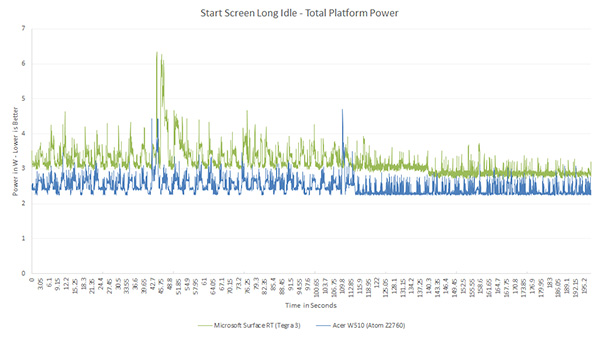
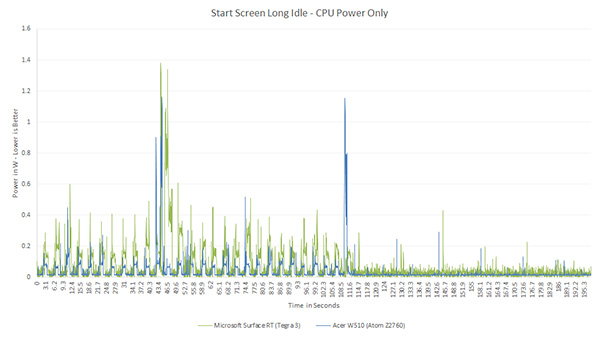
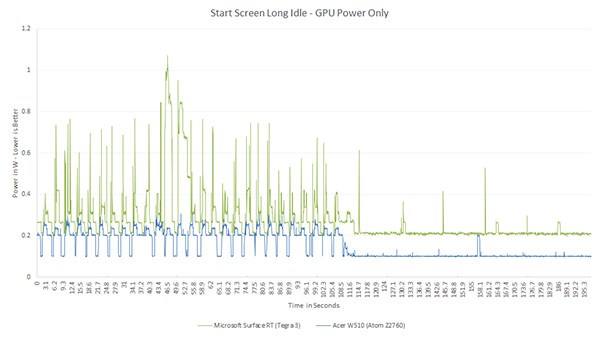

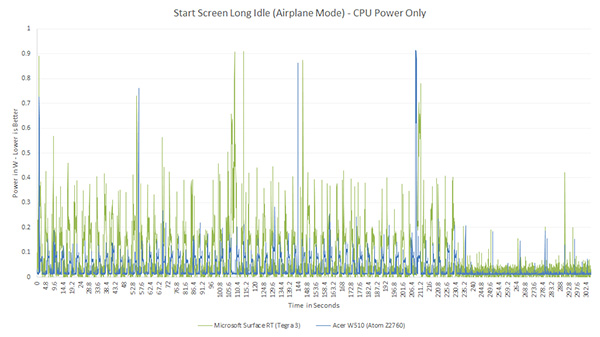
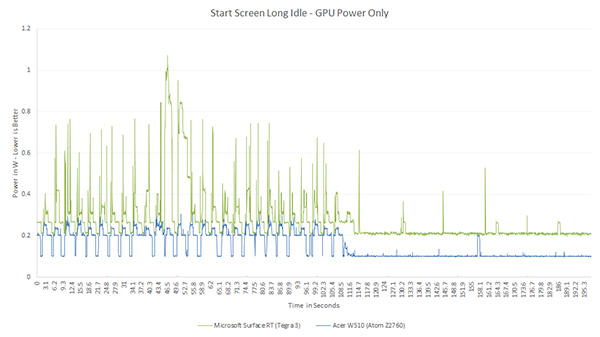








163 Comments
View All Comments
felixyang - Friday, December 28, 2012 - link
You get the keypoint.st.bone - Tuesday, December 25, 2012 - link
Now that's just out right ignorant on your comment, that's if you even took the time to read the articlejeffkibuule - Monday, December 24, 2012 - link
This kind of makes me shake my head as to why a year old SoC was used when Samsung was shipping Exynos 5250 and Qualcomm had APQ8064, heck nVidia has Tegra4 just waiting in the wings for a likely CES announcement (I know why, bad timing).My only hope is that in 2013, ARM and Atom SoCs can support 1080p displays, I don't think I can use anything less without wanting to poke my eyes out.
kyuu - Monday, December 24, 2012 - link
Agreed. This article mostly highlights what an out-of-date SoC Tegra3 is, and how bad it is without its companion core. Which is why its so perplexing that Microsoft went with the Tegra 3 for the Surface. I can only guess that Nvidia must be practically giving away Tegra3 nowadays, otherwise I have no idea why anyone would use it.I'm not sure it's a huge win for Intel that Clover Trail beats a mostly obsolete ARM SoC in power use with such an incredibly mediocre GPU.
A more interesting comparison would be between a current-gen Qualcomm chipset and/or Samsung's current-gen Exynos.
kyuu - Monday, December 24, 2012 - link
To clarify the second "paragraph", Clover Trail is the one with the mediocre GPU.lmcd - Tuesday, December 25, 2012 - link
They're both mediocre GPUs at this point. Didn't Adreno 225 keep pace with the T3 GPU?jeffkibuule - Tuesday, December 25, 2012 - link
The reasoning for going for Tegra 3 was pretty obvious. They needed a more finalized chip to develop Windows RT against and Tegra 3 was the only thing available. Relying on a faster class of SoCs in the Tegra 4, Snapdragon S4 Pro, or Exynos 5250 would mean delaying the Windows RT version of tablets by several months at least since I doubt development would have been done in time.lmcd - Tuesday, December 25, 2012 - link
S4 standard would've done better more likely. Clover Trail demo'ed how viable two cores was for W8, let alone W8 RTwsw1982 - Tuesday, December 25, 2012 - link
There is already the comparison between the medfield, krait, swift and Exynos 5250 on the android platform, isn't there? I think microsoft is the one to blame that you can only compare clover trails and tegra 3 on windows platform, LOLKrysto - Monday, December 24, 2012 - link
Intel will not have anything that even approaches next year's ARM SoC's GPU's anytime soon. And they can't match Cortex A15 in performance anytime soon either.